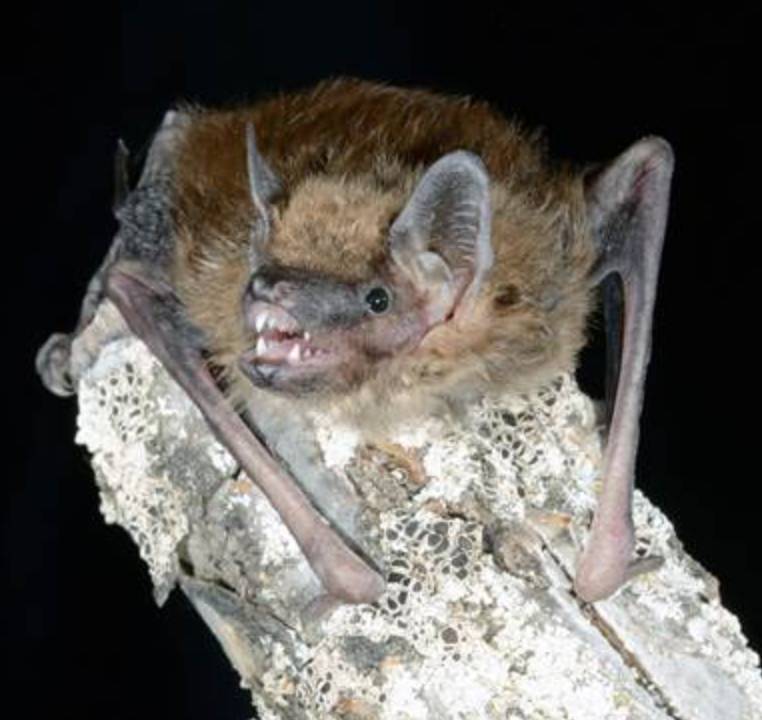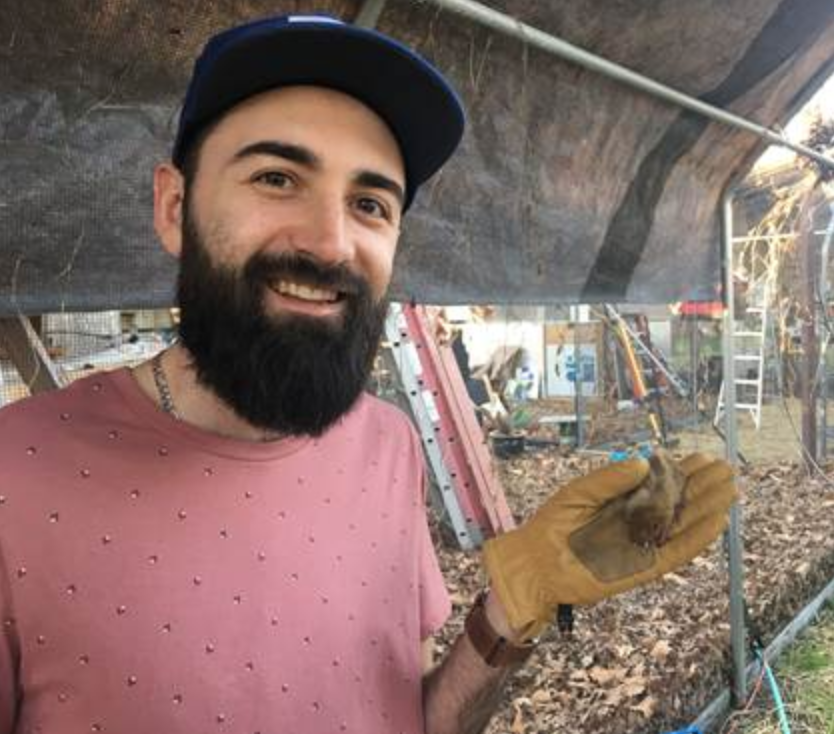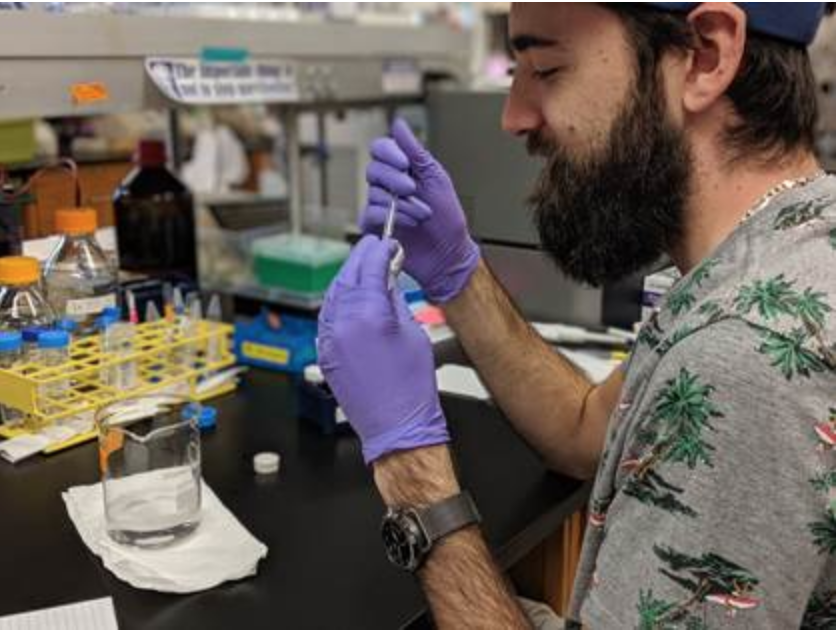By Victoria Farrar
Thousands of bats roost in the eaves of the Congress Avenue bridge in Austin, Texas, each summer, impressing tourists with their huge nightly emergence that swarms into the sunset. In January, however, it’s quiet under the bridge. The bats hibernate in the winter, leaving behind only the musty smell of their droppings in the form of guano. Although the bats may be hibernating in far off locales, this guano might hold clues to the bats’ behavior during their previous mating season in residence. What secrets to the bats’ sex lives could lie inside the pungent residue?
Not far from where the bats convene, thousands of scientists also flocked to Austin for the Society for Integrative and Comparative Biology (SICB) Annual Meeting in January 2020. Among them was Lucas Greville, a Ph.D. student in Psychology, Neuroscience & Behaviour at McMaster University in Canada, who is hoping to address these questions. Greville studies sex steroids that bats transfer to each other through their urine, and how bats might use these chemicals to influence their neighbors’ and mates’ behaviors.
“How to win friends and influence people,” the bat way
The idea that animals can secrete chemical signals, called pheromones, that affect the behaviour of other individuals of the species is not new. For anyone that has taken their dog on a walk and been mortified by the dog’s obsession with other dogs’ rear ends, this is a familiar phenomenon. But these chemicals do more than allow animals to exchange information. Pheromones have been implicated in dramatic reproductive changes in mammals. For example, when new male rodents enter a group, their pheromones can block the uterine implantation of the ova preventing fertilized females from becoming pregnant, or induce early puberty so that they become fertile. By secreting hormones – chemicals that circulate through our blood and control physiology – the males can “hack” the reproductive state of females to their benefit.
Despite these wild findings in rodents, scientists didn’t know if these effects occur in other mammalian species. That’s where Greville and his work comes in. “There’s a lack of information on bats and their physiology and behavior that you would think would be out there,” Greville explains, “and very little literature in the field of bat reproduction in general”. Dr. Denys deCantanzaro, also at McMaster University, had studied these reproductive phenomena in lab mice, but wanted to know if they could happen in other mammals. Given bats’ social structures in colonial roosts, the researchers agreed that bats made an ideal species to test whether pheromones could influence social behavior between individuals. But first, they had to show that the bats were releasing pheromones at all. Greville was an undergraduate at the time and joined the pilot project on bats, stating that “the whole connection between physiology and behavior really interested [him]”.
Greville studies captive big brown bats (Eptesicus fuscus) housed in his home laboratory at McMaster, run by Dr. Paul Faure. But while the rest of Greville’s lab mates are using the bats for neuroscience experiments to understand hearing in the brain, Greville is the first to bring endocrinology, the study of hormones, to the lab’s bats. Using methods perfected in lab mice from his collaborators, he found that both male and female bats are indeed emitting bioactive hormones through their urine. However, these signals differ from other pheromones that can be picked up from scents, like those a dog smells on a walk. Greville found that the hormones from one bat’s pee can be physically transferred from one bat into the body of their neighbor, where they may affect physiology, reproduction and even behavior, just like that animals’ own hormones.
Greville and his collaborators made this discovery by injecting bats with radioactive hormones. While the idea of a bat flying around full of radioactivity may sound like something out of a B horror movie, the work isn’t too scary, according to Greville. He uses tritium, a rare radioactive form of hydrogen. These radioactive hydrogen atoms are incorporated into the chemical structure of key reproductive hormones, like estradiol (commonly referred to as “estrogen”). Then, these radioactively-labeled hormones can be used to track where these hormones go in the body (as most normal hormones don’t contain tritium). Tritium has a short half life and can be easily cleaned out of a lab, so it isn’t as dangerous as isotopes like uranium. Nonetheless, the researchers do take safety precautions to ensure that the radioactivity doesn’t leave their lab space or enter their bodies.
Using this radioactivity as a tracking system, Greville could “follow” the reproductive hormones as they moved through a bat’s body and into the environment. When Greville injected estradiol labeled with tritium into male bats, he found that the radioactivity showed up in the female bats with which they had been housed (and who were not injected themselves). More importantly, the radioactive hormones weren’t just in random places, but appeared mainly in their brains and reproductive organs, where they could affect mating behaviors. So how do these hormones get from one animals’ excrement to another’s internal organs?
Unlike other signals in animal pee, sex hormones like estradiol and testosterone are steroids and are not volatile. This means that these hormones can’t move through the air in a way that our nose can detect them. Instead, the hormones must enter the body and bloodstream in other ways. Instead, Greville has demonstrated that bats can absorb hormones through their skin, using a similar mechanism to those in a nicotine or birth control patch. As wild bats crawl around their guano-lined caves, they may be picking up hormones from their neighbors, which may alter their own behaviors.
Whether or not this transfer of hormones between bats can affect behavior still remains to be tested. Bats have a strange sex life, compared to other mammals. In big brown bats, mating occurs in the fall, and then females will store sperm during winter and through hibernation, ovulating and becoming pregnant in the spring and caring for their one to two pups in the summer. “Ovulation and pregnancy are decoupled. Some bat [species] will fertilize the egg and then halt development or implantation [before hibernation]”, Greville explains, but big brown bats, the species he studies, store sperm. The transfer of hormones from males to females that Greville uncovered during the reproductive season could influence females in the colony, such as their fertility or receptiveness to mating.
Until more work is done on bat behavior, though, whether these hormones can affect behavior remains unknown. “ That rudimentary work hasn’t been done,” Greville laments, “we know less about bat reproductive and mating behavior in general […and] we haven’t tested if [hormone transfer] is enough to change behavior and physiology [in the bats].” Greville is currently working with undergraduates at McMaster to begin to address behavioral questions, such as whether females prefer the scent of male or female bats. These forthcoming studies will help grow knowledge of bat mating behaviors and preferences.
From lab rats to lab bats
Many of Greville’s exciting findings on hormone transfer were first inspired by work done in model rodents like mice and rats. To test if these phenomena are present in bats, Greville has to acclimate bats from the wild into the lab. Each year, members of the Faure lab bring big brown bats from the field to the colony housed on McMaster’s campus. Before any experiments can be run, the bats must get adjusted to their new surroundings and be given the run-down on how to be a lab bat.
Training a wild bat to be a lab bat can be challenging, or at least, time consuming. Students in the lab bond over hand-training the bats to prepare them for life in captivity. “[These bats] used to be flying around catching mosquitoes, junebugs, and moths”, Greville describes, “you have to train them to eat mealworms, […] to drink from a water dish”. The animals must learn feats that they wouldn’t have had to out in nature. “[It’s] crazy in my mind that you can train a wild animal to eat from a dish”, Greville shares, but most of the bats have adjusted to their new setting after the first three days of care and rearing.
With bats trained and protocols in place, experiments were ready to begin. But even when working with something as interesting as radioactive bats and individual-to-individual hormone transfer, the actual work can sometimes be less captivating than the headlines.
To get his data, Greville must spend hours processing the bats to collect urine samples and encouraging them to wet the bed. “[I take] the animals off the wall, [and] collect urine from them using small capillary tubes,” says Greville. To get the bats to pee, Greville capitalizes on their instincts. “Urination is a natural mammalian startle response,” he explains with a laugh. With bat pee in hand (or that is, in many little tubes), there’s more processing to do. “[You have to] blow out the urine you need later,” Greville says, describing how he uses syringes and tubing to push the liquid out of the many small one-millimeter wide tubes . “[I can] spend two weeks blowing out hundreds of samples from their tubes, poking a hole in the sealant, pooling urine into larger tubes. A lot of time just sitting in the lab.” Truly, the bats have really put the “pee” in the Ph.D. for Greville, but the findings he gleans make it worth it.
Despite the not-so-glamorous lab work, the discoveries Greville made are important for unraveling the mystery of bat reproduction, something that scientists still know little about. But from a wider perspective, these studies also help us understand reproduction in general. Sure, “a lot of the work is replicating work done in mice,” Greville posits, “[but] these reproductive elements are found throughout [mammals].” “Unfortunately, you can’t just go injecting radioactive steroids into wild animals,” he says, so using captive bats allows them to “extend this work into a phylogenetically distinct species and show that it can reliably occur […] beyond rodents”. Who knows, there’s a “possibility for transfer to occur in humans, too”, Greville hints, but no one has yet investigated this.
To share this work, Greville also attended the SICB conference for the first time this January. The diverse community of comparative researchers impressed Greville. “I loved that there were so many organisms [represented] and everyone was super receptive to talking about work outside of the standard models,” he shares. “A lot of researchers integrating behavior and physiology […] actually tied it back to their model’s ecology and behavior.” This integrative research inspired Greville. “I wish I had started going earlier in my graduate career”.
As Greville’s work and the multitudes of comparative research each year at SICB highlight, there is still so much about animal physiology we have yet to discover. When it comes to reproductive biology and hormones across new study systems, answering these questions can present exciting, low-hanging fruit. Or maybe, to Greville, it takes the form of a bat, hanging low from the arches of the Congress Avenue bridge.




